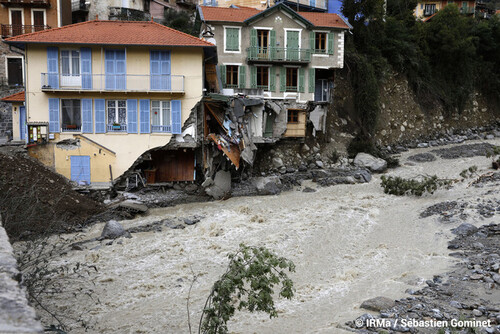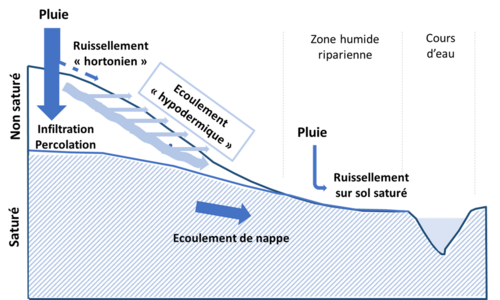Terms of republication
You can republish this article for free on your website, blog, etc.
Flooding: How can flash floods be better prevented?
Eric Gaume, Geotechnics, environment, natural risks and earth sciences Department (GERS) and Juliette Godet, Water and Environment Laboratory (LEE), Gustave Eiffel University.
Far from being regionalised, flood risks affect almost every French municipality. There are several reasons for this phenomenon: overflowing rivers, rising water tables, marine submersion and, more frequently, flash floods and runoff. Two experts from Gustave Eiffel University – Juliette Godet and Eric Gaume – explain the phenomena of flash floods and runoff along with ways to improve their prevention.
With one in four French people living on flood plains, better flood prevention has become a major challenge. Floods, which account for half of all insured claims, can be devastating and are difficult to anticipate and control, especially when they are caused by runoff or flash floods. We all remember the flooding in the Alpes-Maritimes caused by Storm Alex, which hit the headlines in 2020. Examples include the devastating floods in Valencia that have hit the headlines in recent weeks.
Caused by intense, localised rainfall leading to the rapid overflow of one or more rivers, sometimes in a matter of hours, flash floods are more prevalent in the South of France, and especially in the Mediterranean basin. "This is due to Mediterranean conditions. During the autumn, the sea remains warm, generating masses of warm, moisture-laden air through evaporation, which can form thunderstorms and heavy rain when passing over the mountainous terrain fringing the Mediterranean in the Cevennes, the Alps, the Pyrenees and Corsica", explains Juliette Godet, a public works engineer and doctoral student in the Water and Environment Laboratory (LEE) at Gustave Eiffel University.

"Avoid extrapolation"
Due to the rise in temperatures caused by climate change, France is experiencing more pronounced summer droughts and more frequent rainfall and storms. But does this mean that flash floods are on the increase? "A marked increase in intense rainfall has been observed in the Mediterranean region, but it occurs on slightly drier soils in the autumn, so the catchment areas react less strongly to the rain", explains Eric Gaume, a hydrology researcher and Head of the Geotechnical Environment, Natural Risks and Earth Sciences Department (GERS) at Gustave Eiffel University, before cautiously adding: "however, we must avoid extrapolation. Recent papers show that there is a great deal of variability, particularly at regional level, depending on the origin of the major floods and the impact of climate change, which may lead to an increase or decrease in some cases, particularly in Europe".

Improving the prevention of flash floods
Floods are now a recurring phenomenon, which can be anticipated reasonably well using tools such as the "Vigicrues" and "Vigicrues Flash" services, which produce forecasts for the main rivers and flash flood warnings for different parts of the country. "Some catchment areas are instrumented. This means that devices are installed to determine water level and flow at certain points along rivers, but it is impossible to install them everywhere", points out Juliette Godet. Seventeen flood forecasting services ensure real-time flood observation in France. Instrumented sites provide a wealth of data on previous floods, thereby facilitating the forecasting of future floods.
However, flash floods are more likely to occur on small rivers, which will overflow more quickly, causing flooding, and which are generally not equipped with measuring instruments. In these areas, the "Vigicrues Flash" tool has been developed to compensate for the lack of coverage by the Vigicrues service, and to enable mayors, network and motorway managers and mobile operators to better anticipate such flooding. "This is a much simpler tool that complements Vigicrues", says Juliette Godet, "which takes parameters such as rainfall intensity and soil moisture into account in order to estimate the risk of flash floods on certain rivers that are not covered by Vigicrues".

Glossary
Arrêtés CatNat: French emergency natural disaster orders
Flash floods: Rapid overflowing of a river caused by intense, localised rainfall. Typical flood and recession times of a few hours. The South of France is the worst affected region.
Runoff: Refers to any surface flow outside the perennial hydrographic network, whatever the origin of this flow.
DGPR: Direction générale de la prévention des risques (Directorate General for Risk Prevention)
Hortonian runoff: Runoff caused by rainfall intensity exceeding the soil infiltration capacity
Surface sealing: Breakdown of the surface soil structure under the impact of rain when it is not protected by vegetation, leading to a sharp reduction in the soil's infiltration capacity and therefore generating run-off during intense rainfall.
Preferential flow: Non-uniform downward movement of groundwater along preferred pathways, including funnel flow and macropore flow.
The interview was conducted by support team for public policies.
Identity card of the article
| Title: | How can flash floods be better prevented? |
| Experts Interviewed: | Eric Gaume and Juliette Godet - Gustave Eiffel University |
| Licence: | This article is published under licence CC BY-SA 4.0. |
| Publication date: | November 12, 2024 |
| Languages: | English/French |
| Keywords: | Flash floods, runoff, vigicrues flash network, CMVRH |
![[Translate to English:] Licence creative commons BY-SA 4.0 [Translate to English:] Licence creative commons BY-SA 4.0](https://reflexscience.univ-gustave-eiffel.fr/fileadmin/ReflexScience/Accueil/Logos/CCbySA.png)